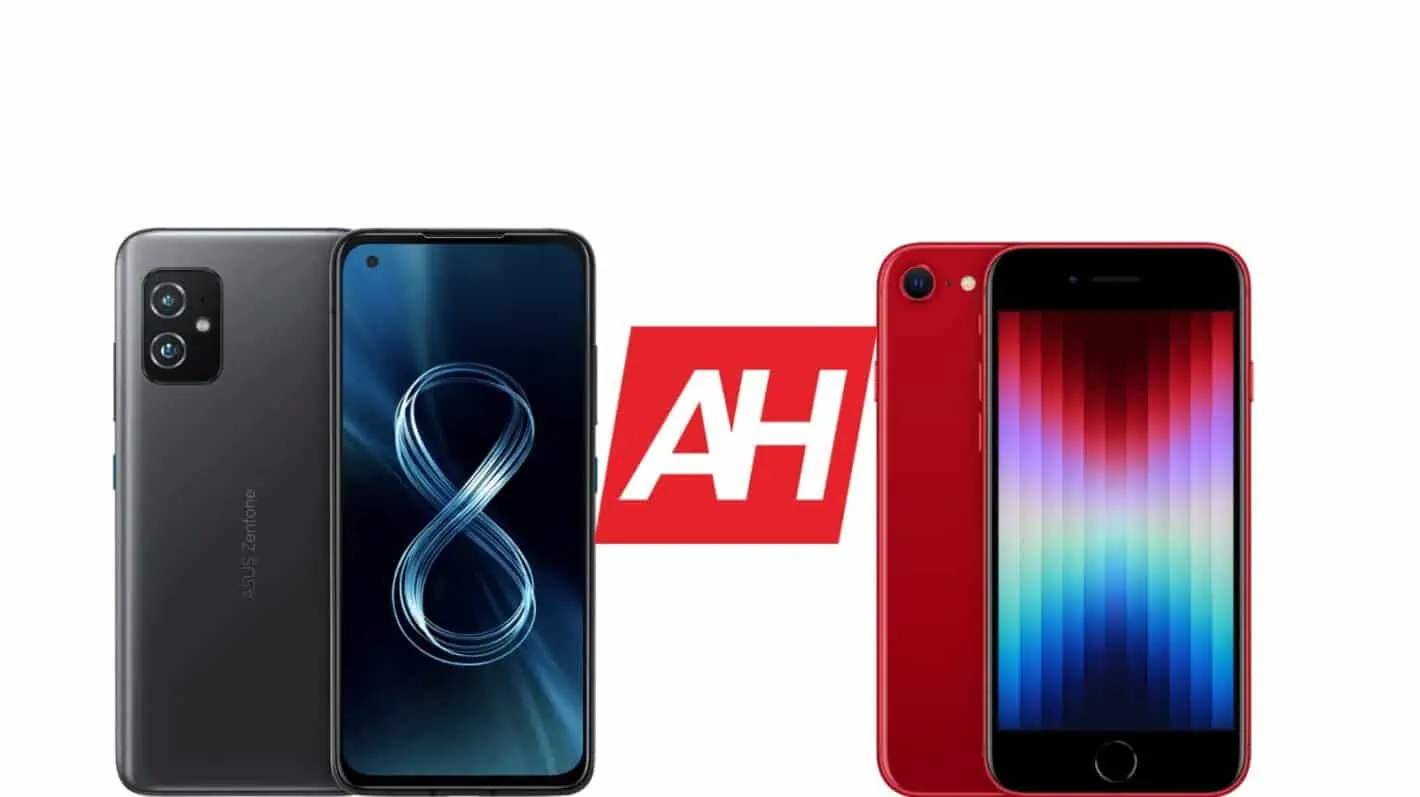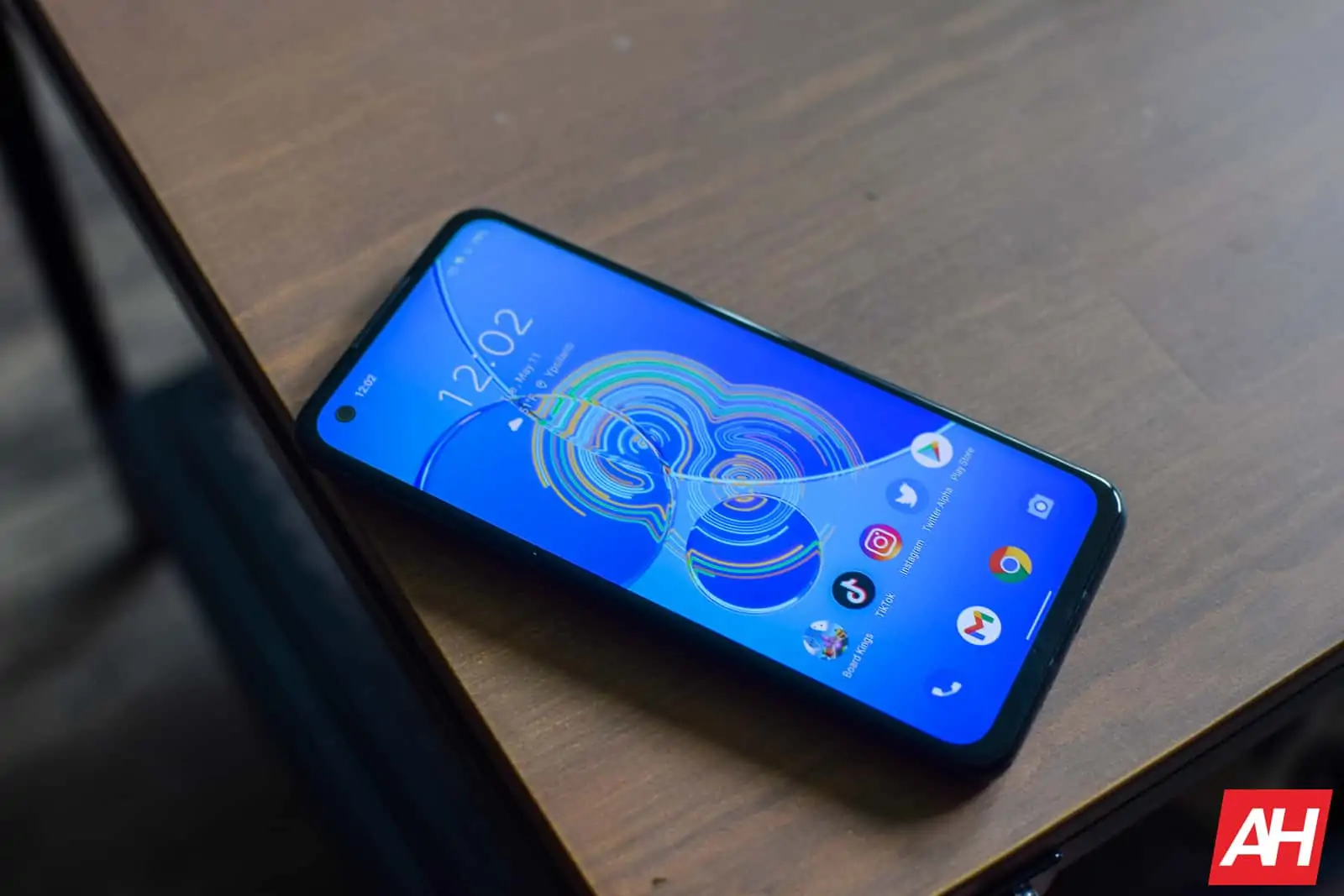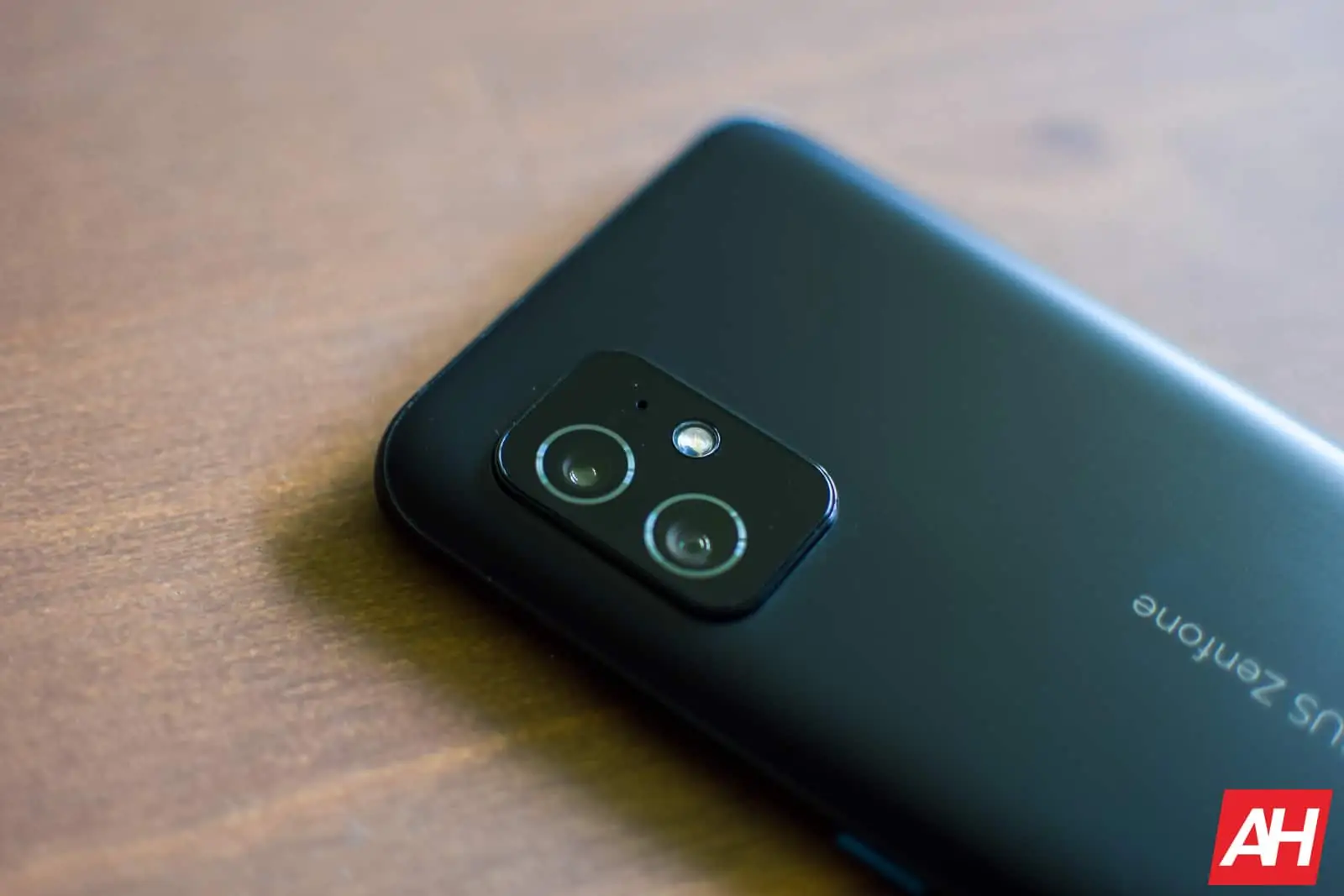There are not many compact Android flagships out there. The ASUS ZenFone 8 is one of the very few examples. That is exactly why we’ll compare the ASUS ZenFone 8 vs Apple iPhone SE (2022) in this article. The iPhone SE (2022) isn’t exactly a flagship smartphone, not at all. It does come with a flagship processor, though. It is fueled by the Apple A15 Bionic, which fuels the iPhone 13 lineup as well.
That processor enables the device to offer rather excellent performance, amongst other things. We’ve already compared the iPhone SE (2022) with the Pixel 5a and 4a, so it seems appropriate to compare it to a more powerful ZenFone 8, mainly due to their similar size. These two phones are quite different, though, in many ways, so that should make this comparison rather interesting. Let’s kick off the ASUS ZenFone 8 vs Apple iPhone SE (2022) comparison.
Specs
| ASUS ZenFone 8 | Apple iPhone SE (2022) | |
| Screen size | 5.9-inch fullHD+ Super AMOLED flat display (120Hz refresh rate) | 4.7-inch HD+ Retina IPS LCD display (60Hz) |
| Screen resolution | 2400 x 1080 | 1334 x 750 |
| SoC | Qualcomm Snapdragon 888 | Apple A15 Bionic |
| RAM | 6GB/8GB/16GB | 4GB |
| Storage | 128GB/256GB (UFS 3.1); non-expandable | 64GB, 128GB, 256GB, non-expandable |
| Rear cameras | 64MP (f/1.8 aperture, 0.8um pixel size, 26mm lens, PDAF, OIS) 12MP (ultra-wide, f/2.2 aperture, 112-degree FoV, 14mm lens, 1.4um pixel size, dual pixel PDAF) |
12MP (f/1.8 aperture, wide-angle, OIS, PDAF) |
| Front cameras | 12MP (f/2.5 aperture, 28mm lens, 1.22um pixel size, dual pixel PDAF) | 7MP (f/2.2 aperture) |
| Battery | 4,000mAh, non-removable, 30W wired charging, reverse wired charging | 1,821mAh (speculated), 18W wired charging, Qi wireless charging |
| Dimensions | 148 x 68.5 x 8.9mm | 138.4 x 67.3 x 7.3mm |
| Weight | 169 grams | 144 grams |
| Connectivity | 5G, LTE, NFC, Bluetooth 5.2, Wi-Fi, USB Type-C | 5G, LTE, NFC, Bluetooth 5.0, Wi-Fi, Lightning |
| Security | In-display fingerprint scanner (optical) | Touch ID |
| OS | Android 11 ZenUI 8 |
iOS 15.3 |
| Price | €599 / €669 / €799 / starting at $629 | $429 |
| Buy | ASUS | Apple |
ASUS ZenFone 8 vs Apple iPhone SE (2022): Design
These two devices look considerably different. They’re both made out of metal and glass, but that’s basically where similarities end. The iPhone SE (2022) has considerably thicker bezels than the ZenFone 8. That is the reason why the two phones are somewhat similar in size, despite the fact the ZenFone 8 has a much larger display. The ZenFone 8 has fairly thin bezels, and a display camera hole in the top-left corner.
The iPhone SE (2022) has a button below the display, which doubles as a fingerprint scanner. The ZenFone 8 packs an in-display fingerprint scanner, an optical one. The ZenFone 8 has two cameras on the back, while the iPhone SE (2022) has one. The ZenFone 8 is also more curved on the back in comparison, as it curves towards the sides, much more than Apple’s handset. The in-hand feel of these two phones is also quite different.
The ZenFone 8 is taller, wider, and thicker than the iPhone SE (2022), while it is also considerably heavier. It weighs 169 grams, compared to 144 grams of the iPhone SE (2022). Truth be said, neither of these two devices is heavy, per se. They both feel like premium devices, even though the iPhone SE (2022) doesn’t exactly look like one. Its design is quite old at this point, though it looks much better in real life than it does in renders.
ASUS ZenFone 8 vs Apple iPhone SE (2022): Display
The ASUS ZenFone 8 features a 5.9-inch fullHD+ (2400 x 1080) Super AMOLED display with a 120Hz refresh rate. This display is flat, and it supports HDR10+ content. It gets quite bright at 1,100 nits of peak brightness. The panel is protected by the Gorilla GLass Victus, by the way. We’re looking at a 20:9 display aspect ratio, and a screen-to-body ratio of around 83-percent.
The iPhone SE (2022), on the other hand, includes a 4.7-inch HD+ (1334 x 720) display. This is a Retina IPS LCD display with a typical brightness of 625 nits. It is a 60Hz display. The display offers a 16:9 aspect ratio, and the device has a screen-to-body ratio of 65.4-percent. That says a lot about the phone’s bezels. As you can see, these two panels differ a lot, not only by resolution and refresh rate, but the aspect ratio and display tech as well.
Needless to say, the ZenFone 8 has a better display. Not only is it an AMOLED display, but it also offers a much higher refresh rate, and it’s also sharper. The iPhone SE (2022) display is not bad, per se, but it’s quite old at this point, and it simply can’t compete with newer and technically superior displays. The ZenFone 8’s display will feel smoother, the blacks will be deep as it’s an AMOLED panel, while it also offers slightly better viewing angles. The colors look very nice on both, though, and both are quite responsive.
ASUS ZenFone 8 vs Apple iPhone SE (2022): Performance
The performance, as you’d expect, is excellent on both phones. The ZenFone 8 is fueled by the Snapdragon 888 SoC, while it packs in 6GB, 8GB, or 12GB of RAM, depending on the variant. That is LPDDR5 RAM, by the way. The iPhone SE (2022), on the other hand, is fueled by the Apple A15 Bionic SoC, and it includes 4GB of RAM. We’re not sure what RAM Apple used, but it’s likely not LPPDR5.
That chip inside the iPhone SE (2022) is more powerful than the Snapdragon 888. So, despite the fact the ZenFone 8 has technically superior RAM, the combination of the Apple A15 Bionic, iOS, and that small HD+ display, make this phone fly through anything. The ZenFone 8 is not a slouch either, not at all, it also powers through anything you throw at it. Both phones are immensely snappy, to be quite honest.
Apple’s device is expected to perform this way for longer, if you’re planning to keep both phones for years. Who knows what can happen down the line, though. At the time being, both phones offer truly excellent performance, and you really can’t go wrong with either. Regardless of whether you’re browsing the Internet, consuming multimedia, gaming, or doing something else entirely, both phones will keep up in style.
ASUS ZenFone 8 vs Apple iPhone SE (2022): Battery
The ASUS ZenFone 8 comes with a 4,000mAh battery. Apple didn’t officially announce the battery capacity of the iPhone SE (2022), but according to a recent teardown, we’re looking at a 2,018mAh battery capacity. That battery is a bit larger than the one in the iPhone SE (2020), as that phone had a 1,821mAh battery pack. The ZenFone 8 does have a much larger battery, though it does include a much larger, and sharper display, which is also a high refresh rate panel. Android also handles battery consumption differently.
Does the ZenFone 8 offer better battery life, though? Well… yes, it does. That is a rather beefy battery for the phone’s size and everything, and the device offers truly great battery life. Getting 7 hours of screen-on-time with our usage wasn’t a problem at all, which puts this phone really high on our battery consumption list. The iPhone SE (2022), on the other hand, definitely won’t be able to go that far. Some of you may be able to get around 5 hours of screen-on-time, but if you end up pushing the phone a bit harder, you’ll land under that mark. It’s always a slippery slope to talk about battery life, though, as it can differ a lot from one person to the next. We all have different usage, and live in different places, plus our habits are different.
Now, in regards to charging. The ZenFone 8 supports 30W fast wired charging, which will get you to around 60-percent in 25 minutes, and a full charge takes 80 minutes. The iPhone SE (2022) supports 18W wired charging, and you can get up to 50-percent in 30 minutes. Do note that the iPhone SE (2022) also supports wireless charging, though it’s really slow. The ZenFone 8 does not support wireless charging.
ASUS ZenFone 8 vs Apple iPhone SE (2022): Cameras
Both the ZenFone 8 and iPhone SE (2022) are compelling camera smartphones. They’re not the best in the game, not at all, but if you’re looking for a solid camera smartphone, both of these will do. Each of them has its advantages. The ZenFone 8 includes two cameras on the back, wide and ultrawide ones. The iPhone SE (2022) has only its main camera on the back, no secondary offering.
The ZenFone 8 does a really good job across the board. It can provide really detailed daytime images, with great foliage representation, and good HDR performance. The images tend to look a bit uninspired sometimes, but you can always boost them with light editing. It does a great job in low light too, some images will even look more like day than night. The iPhone SE (2022) does an excellent job in daylight, it provides really balanced shots, but unfortunately, Apple didn’t include Night Mode here. Still, the iPhone SE (2022) is still capable in low light, as long as we’re not talking about truly dark scenes, in those the ZenFone 8 does a considerably better job.
The video recording is better on the iPhone SE (2022), in case you were wondering. All in all, both are quite capable, but are not the best smartphone cameras around. If you’re looking for something like that, you’ll need to look elsewhere.
Audio
When it comes to sound, well, the ZenFone 8 is the better option. That device not only comes with an audio jack, unlike the iPhone SE (2022), but it also offers better speakers. Both phones include stereo speakers, but the quality built into the ZenFone 8’s is on another level. The phone has excellent speakers despite the phone’s compact size, which is not something we see often these days.
These speakers can provide 32-bit/384kHz audio, and they’re not only louder than the ones in the iPhone SE (2022), they also offer a wider soundstage. The iPhone SE (2022) speakers are good overall, but they pale in comparison with the ZenFone 8’s. You’re also getting Bluetooth 5.2 on that phone, instead of Bluetooth 5.0 on the iPhone SE (2022), which is a better solution if you’re planning to use wireless earphones.



